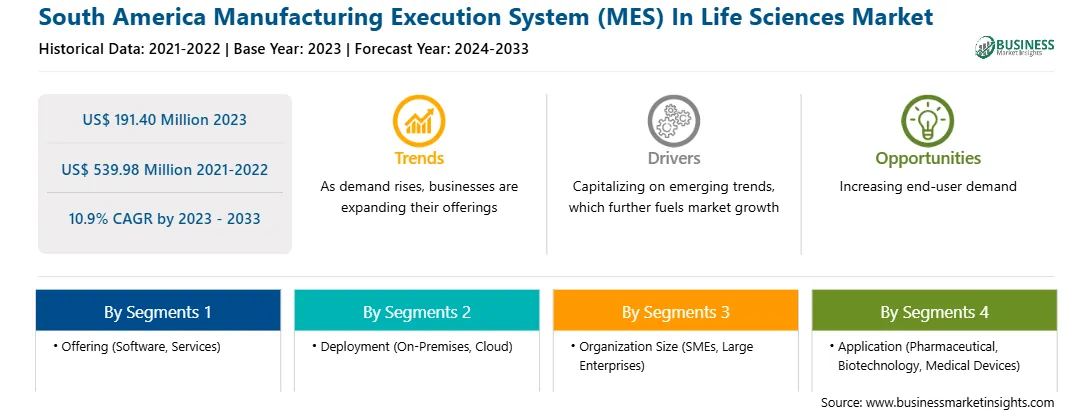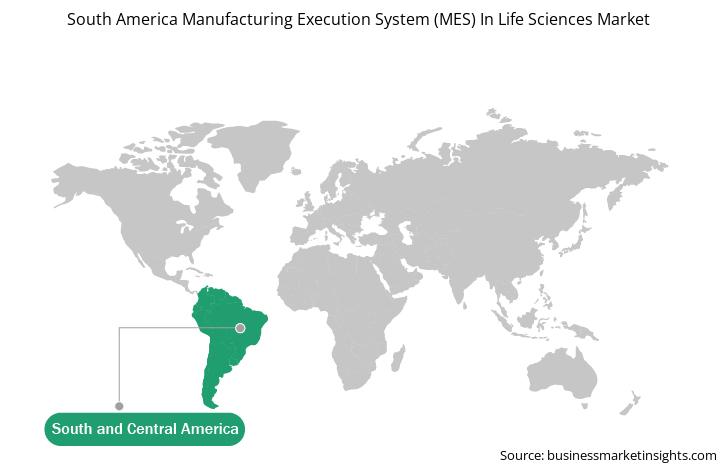South America Manufacturing Execution System (MES) In Life Sciences Market
No. of Pages: 118 | Report Code: BMIRE00028430 | Category: Technology, Media and Telecommunications
No. of Pages: 118 | Report Code: BMIRE00028430 | Category: Technology, Media and Telecommunications
The growing digitization in the pharmaceutical industry is raising the demand for Pharma 4.0. The model helps increase connectivity and productivity, simplify compliance, and marshal production information to respond to problems as they emerge. The Pharma 4.0 model helps transform the manufacturing workforce by connecting workers to more human-centric workflows by shifting the company culture. Various regulatory bodies, such as International Society for Pharmaceutical Engineering (ISPE) and its members, are developing a roadmap to introduce Pharma 4.0. The objective of the Pharma 4.0 model is to enable organizations to leverage the full potential of digitalization to provide faster therapeutic innovations and improve production processes for the patient's benefit. Pharma 4.0 allows organizations to connect teams, uphold compliance standards and provide deep analytics, enhancing safety, yield, and quality. Thus, Pharma 4.0 helps provide real-time data and predictive analysis to optimize production, improve quality assurance and regulatory compliance, reduce risk, and enhances business. MES is a crucial element of Pharma 4.0 as it links machines and systems together to create intelligent networks that control each other, ensure better process flow, and can be programmed to trigger automatic processes as needed. Intelligent MES and EBR are being developed, specifically for smaller factories and plants, to promote the adoption of Pharma 4.0 among such stakeholders. Key players of the Pharma 4.0 ecosystem are collaborating to accelerate the adoption of the same. For instance, in March 2021, Lonza and NNIT announced a partnership to speed up MES projects. Under this partnership, the companies will combine Lonza’s MODA Platform with NNIT’s Accelerated Implementation Methodology. Thus, with this, the companies will get a complete pharma 4.0 solution and achieve their digitalization vision faster than ever. Therefore, all the above factors are increasing the adoption of Pharma 4.0, fueling the growth of the manufacturing execution system in life sciences market.
South America manufacturing execution system market is segmented into Brazil, Argentina, and the Rest of South America. Various vendors can attract new customers and expand their footprint in emerging markets of South America with new technological advancements. At present, South America accounts for ~3% share of the global pharmaceutical industry. The pharmaceutical industry in the region grew at an annual rate of ~7% through 2023. Brazil alone holds the largest share of this industry. The pharmaceutical manufacturing industry in the country has positioned itself to serve other emerging South American markets as well.
Strategic insights for the South America Manufacturing Execution System (MES) In Life Sciences provides data-driven analysis of the industry landscape, including current trends, key players, and regional nuances. These insights offer actionable recommendations, enabling readers to differentiate themselves from competitors by identifying untapped segments or developing unique value propositions. Leveraging data analytics, these insights help industry players anticipate the market shifts, whether investors, manufacturers, or other stakeholders. A future-oriented perspective is essential, helping stakeholders anticipate market shifts and position themselves for long-term success in this dynamic region. Ultimately, effective strategic insights empower readers to make informed decisions that drive profitability and achieve their business objectives within the market. The geographic scope of the South America Manufacturing Execution System (MES) In Life Sciences refers to the specific areas in which a business operates and competes. Understanding local distinctions, such as diverse consumer preferences (e.g., demand for specific plug types or battery backup durations), varying economic conditions, and regulatory environments, is crucial for tailoring strategies to specific markets. Businesses can expand their reach by identifying underserved areas or adapting their offerings to meet local demands. A clear market focus allows for more effective resource allocation, targeted marketing campaigns, and better positioning against local competitors, ultimately driving growth in those targeted areas.
South America Manufacturing Execution System (MES) In Life Sciences Strategic Insights

South America Manufacturing Execution System (MES) In Life Sciences Report Scope
Report Attribute
Details
Market size in 2023
US$ 191.40 Million
Market Size by 2033
US$ 539.98 Million
Global CAGR (2023 - 2033)
10.9%
Historical Data
2021-2022
Forecast period
2024-2033
Segments Covered
By Offering
By Deployment
By Organization Size
By Application
Regions and Countries Covered
South and Central America
Market leaders and key company profiles
South America Manufacturing Execution System (MES) In Life Sciences Regional Insights

The South America manufacturing execution system in life sciences market is segmented into offering, deployment, organization size, application, and country.
Based on offering, the South America manufacturing execution system in life sciences market is segmented into software and services. The services segment held a larger share of the South America manufacturing execution system in life sciences market in 2023.
Based on deployment, the South America manufacturing execution system in life sciences market is segmented into on-premises and cloud. The cloud segment held a larger share of the South America manufacturing execution system in life sciences market in 2023.
Based on organization size, the South America manufacturing execution system in life sciences market is segmented into SMEs and large enterprises. The large enterprises segment held the largest share of the South America manufacturing execution system in life sciences market in 2023.
Based on application, the South America manufacturing execution system in life sciences market is segmented into pharmaceutical, biotechnology, and medical devices. The medical devices segment held the largest share of the South America manufacturing execution system in life sciences market in 2023.
Based on country, the South America manufacturing execution system in life sciences market is segmented into Brazil, Argentina, and the Rest of South America. Brazil dominated the share of the South America manufacturing execution system in life sciences market in 2023.
Emerson Electric Co; Rockwell Automation Inc; Schneider Electric SE; and Siemens AG are the leading companies operating in the South America manufacturing execution system in life sciences market.
The South America Manufacturing Execution System (MES) In Life Sciences Market is valued at US$ 191.40 Million in 2023, it is projected to reach US$ 539.98 Million by 2033.
As per our report South America Manufacturing Execution System (MES) In Life Sciences Market, the market size is valued at US$ 191.40 Million in 2023, projecting it to reach US$ 539.98 Million by 2033. This translates to a CAGR of approximately 10.9% during the forecast period.
The South America Manufacturing Execution System (MES) In Life Sciences Market report typically cover these key segments-
The historic period, base year, and forecast period can vary slightly depending on the specific market research report. However, for the South America Manufacturing Execution System (MES) In Life Sciences Market report:
The South America Manufacturing Execution System (MES) In Life Sciences Market is populated by several key players, each contributing to its growth and innovation. Some of the major players include:
The South America Manufacturing Execution System (MES) In Life Sciences Market report is valuable for diverse stakeholders, including:
Essentially, anyone involved in or considering involvement in the South America Manufacturing Execution System (MES) In Life Sciences Market value chain can benefit from the information contained in a comprehensive market report.